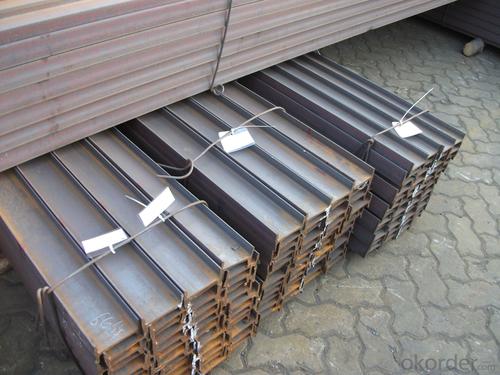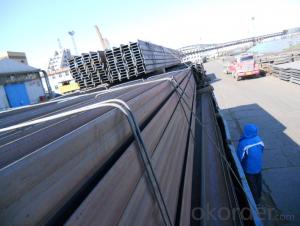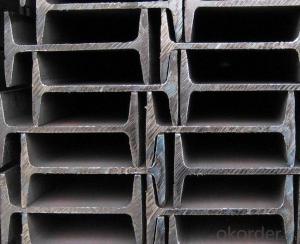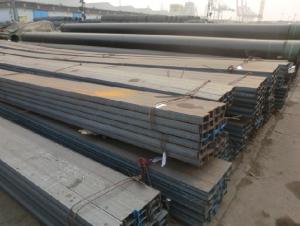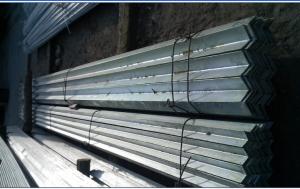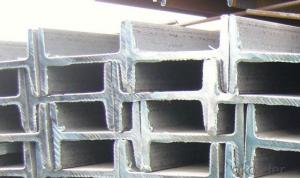Rent Ipe/Ipeaa Steel Beams
- Loading Port:
- Tianjin
- Payment Terms:
- TT OR LC
- Min Order Qty:
- 2000 m.t.
- Supply Capability:
- 20000 m.t./month
OKorder Service Pledge
OKorder Financial Service
You Might Also Like
Product Description:
Specifications of I BEAM European standard of IPE and IPEAA
size | Kg/m |
IPE 100*55*4.1 | 8.1 |
IPEAA 100*55*3.6 | 6.72 |
IPE 120*64*4.4 | 10.4 |
IPEAA 120*64*3.8 | 8.36 |
IPE 140*73*4.7 | 12.9 |
IPEAA 140*73*3.8 | 10.05 |
IPE 160*82*5.0 | 15.8 |
IPEAA 160*82*4 | 12.31 |
IPE 200*100*5.6 | 22.4 |
IPEAA 200*100*4.5 | 17.95 |
Grade: Q235B, Q235, Q345B, SS400, A36 etc
Standard: EN standard etc
Length: 6m, 12m, or as the customers’ requirements.
Usage of I BEAM European standard of IPE and IPEAA :
1.Support structures 2.Pre-engineered buildings 3.Prefabricated structure
4.It is widely used in various building structures and engineering structures such as roof beams, bridges, transmission towers, hoisting machinery and transport machinery, ships, industrial furnaces, reaction tower, container frame and warehouse etc.
Payment terms: TT or LC.
Package: packed in bundles and then shipped by break bulk or containers.
- Q:In the welding of steel structure, the welding between I-beam and stiffener needs three sides to be welded
- When the I-beam is the main load, it is recommended that all welds be fully welded
- Q:What are the advantages of using painted steel I-beams?
- There are several advantages of using painted steel I-beams. Firstly, the paint provides a protective layer against corrosion, extending the lifespan of the beams and reducing maintenance costs. Additionally, painted steel I-beams offer aesthetic appeal, allowing them to blend well with the surrounding environment. The paint also provides a smooth finish, reducing the risk of splinters or sharp edges. Lastly, the color selection of painted steel I-beams allows for better visibility and differentiation, enhancing safety and organization in construction and industrial settings.
- Q:How do you calculate the moment of inertia for steel I-beams?
- In order to determine the moment of inertia for steel I-beams, one must take into account the specific dimensions and shape of the beam. The moment of inertia measures the object's resistance to rotational motion around a specific axis. For I-beams, the moment of inertia refers to their resistance to bending or flexing around their central axis. The moment of inertia formula for an I-beam can be derived using basic principles of calculus. It involves dividing the beam into smaller sections and summing up the contributions from each section. The moment of inertia is influenced by the beam's cross-sectional shape and dimensions, particularly the area and the distance from the centroid or neutral axis. To calculate the moment of inertia for an I-beam, the following formula can be used: I = (b1 * h1^3) / 12 + (b2 * h2^3) / 12 + (2 * A * d^2) Where: - I represents the moment of inertia - b1 and h1 represent the width and height of the top flange - b2 and h2 represent the width and height of the bottom flange - A represents the area of the web (the vertical section connecting the two flanges) - d represents the distance from the centroid of the web to the centroid of the top flange To calculate the moment of inertia, one must obtain or measure the dimensions of the I-beam, including the dimensions of the flanges (top and bottom) and the web. Once the measurements are obtained, they can be substituted into the formula to determine the moment of inertia. It is important to emphasize that the moment of inertia plays a crucial role in structural engineering. It helps determine the beam's ability to resist bending, deflection, and torsion, which are essential factors in designing structures that are safe and efficient.
- Q:Can steel I-beams be used for mezzanines or elevated platforms?
- Yes, steel I-beams can definitely be used for mezzanines or elevated platforms. Steel I-beams are commonly used in construction due to their strength and durability. They can support heavy loads and provide a stable structure for creating additional floor space, such as mezzanines or elevated platforms. Steel I-beams are also versatile and can be easily customized to fit specific design requirements. Additionally, steel I-beams offer long-term reliability and require minimal maintenance, making them an ideal choice for constructing mezzanines or elevated platforms.
- Q:Are steel I-beams suitable for crane runway beams?
- Yes, steel I-beams are suitable for crane runway beams. Steel I-beams are commonly used in construction and are known for their strength and durability. They have a high load-bearing capacity, making them ideal for supporting the heavy loads that cranes typically carry. Additionally, steel I-beams can be customized to meet the specific requirements of crane runways, such as length and width. They are also resistant to corrosion, which is important for outdoor or industrial environments where cranes are commonly used. Overall, steel I-beams are a reliable and suitable choice for crane runway beams.
- Q:Can steel I-beams be used in high-rise buildings?
- Yes, steel I-beams are commonly used in high-rise buildings due to their strength, durability, and ability to handle heavy loads. They provide structural support and stability, making them suitable for constructing tall and large-scale structures.
- Q:How do you calculate the shear force in a steel I-beam?
- To calculate the shear force in a steel I-beam, you need to consider the applied loads and the structural properties of the beam. The shear force represents the internal force that acts parallel to the longitudinal axis of the beam, causing it to deform or fail. To calculate the shear force, you must first determine the external loads acting on the beam, such as point loads, distributed loads, or moments. These loads can be determined from the design or analysis of the specific structure or from the application of the beam. Once the external loads are known, you can analyze the distribution of these loads over the length of the beam. This involves determining the position and magnitude of the loads at various points along the beam. For example, if you have a uniformly distributed load, you would need to determine the load per unit length. Next, you need to determine the support conditions of the beam, such as whether it is simply supported or fixed at both ends. This information is crucial in calculating the reactions at the supports, as they will influence the shear force. After determining the load distribution and the support conditions, you can proceed to calculate the shear force at any given point along the beam. To do this, you need to consider the equilibrium of forces at that specific point. At any section of the beam, the sum of the vertical forces must be equal to zero. By considering the external loads and the reactions at the supports, you can calculate the shear force at that specific section. This can be done using the method of sections or by calculating the change in shear force between two neighboring sections. Additionally, it is important to consider the structural properties of the steel I-beam, such as its moment of inertia and the distance from the neutral axis to the extreme fibers. These properties influence the distribution of shear force within the beam and must be taken into account during the calculations. Overall, calculating the shear force in a steel I-beam requires a thorough analysis of the external loads, support conditions, and structural properties. By applying the principles of equilibrium and considering the specific characteristics of the beam, you can accurately determine the shear force at any point along the beam.
- Q:Can steel I-beams be used for telecommunications infrastructure?
- No, steel I-beams are not typically used for telecommunications infrastructure. Telecommunications infrastructure typically requires lighter materials that can support the installation of equipment such as antennas and cables. Steel I-beams are more commonly used in construction for their strength and load-bearing capabilities.
- Q:Can Steel I-Beams be used for agricultural buildings?
- Certainly, agricultural buildings can indeed utilize steel I-beams. Renowned for their robustness and longevity, steel I-beams prove to be an ideal choice for supporting extensive agricultural structures. They are frequently employed in the construction of barns, stables, storage facilities, and other agricultural edifices. With their exceptional load-bearing capacities, steel I-beams can effortlessly withstand the demands of heavy equipment, machinery, and storage necessities commonly found in agricultural operations. Moreover, steel's resistance to pests, fire, and decay renders it a dependable option for agricultural buildings that must endure harsh environmental conditions. Furthermore, the versatility and ease of assembly of steel I-beams enable flexible designs that can adapt to diverse agricultural requirements.
- Q:Are there any building codes or regulations that govern the use of steel I-beams?
- Steel I-beams in construction are subject to building codes and regulations that vary by country and jurisdiction. These guidelines govern the design, installation, and structural integrity of steel I-beams. In the United States, the International Building Code (IBC) regulates the use of steel I-beams and is adopted by most states and local jurisdictions. The IBC sets minimum requirements for building design and construction, including specifications for steel I-beams. It covers aspects such as beam size, shape, strength, and the connections and fasteners to be used. Different types of construction, such as residential, commercial, and industrial buildings, have specific codes and standards for steel I-beam usage. The American Institute of Steel Construction (AISC) provides standards for designing and constructing steel structures, including guidelines for steel I-beams. Other countries have their own building codes and regulations for steel I-beams, often based on international standards set by organizations like the International Organization for Standardization (ISO) and the European Committee for Standardization (CEN). To ensure the safety and structural integrity of buildings, architects, engineers, and builders must comply with these building codes and regulations. Failure to do so can lead to legal consequences and jeopardize the safety of occupants and the overall performance of the structure. Hence, it is crucial to consult and follow the relevant building codes and regulations when using steel I-beams in construction projects.
1. Manufacturer Overview |
|
|---|---|
| Location | |
| Year Established | |
| Annual Output Value | |
| Main Markets | |
| Company Certifications | |
2. Manufacturer Certificates |
|
|---|---|
| a) Certification Name | |
| Range | |
| Reference | |
| Validity Period | |
3. Manufacturer Capability |
|
|---|---|
| a)Trade Capacity | |
| Nearest Port | |
| Export Percentage | |
| No.of Employees in Trade Department | |
| Language Spoken: | |
| b)Factory Information | |
| Factory Size: | |
| No. of Production Lines | |
| Contract Manufacturing | |
| Product Price Range | |
Send your message to us
Rent Ipe/Ipeaa Steel Beams
- Loading Port:
- Tianjin
- Payment Terms:
- TT OR LC
- Min Order Qty:
- 2000 m.t.
- Supply Capability:
- 20000 m.t./month
OKorder Service Pledge
OKorder Financial Service
Similar products
New products
Hot products
Hot Searches
Related keywords



